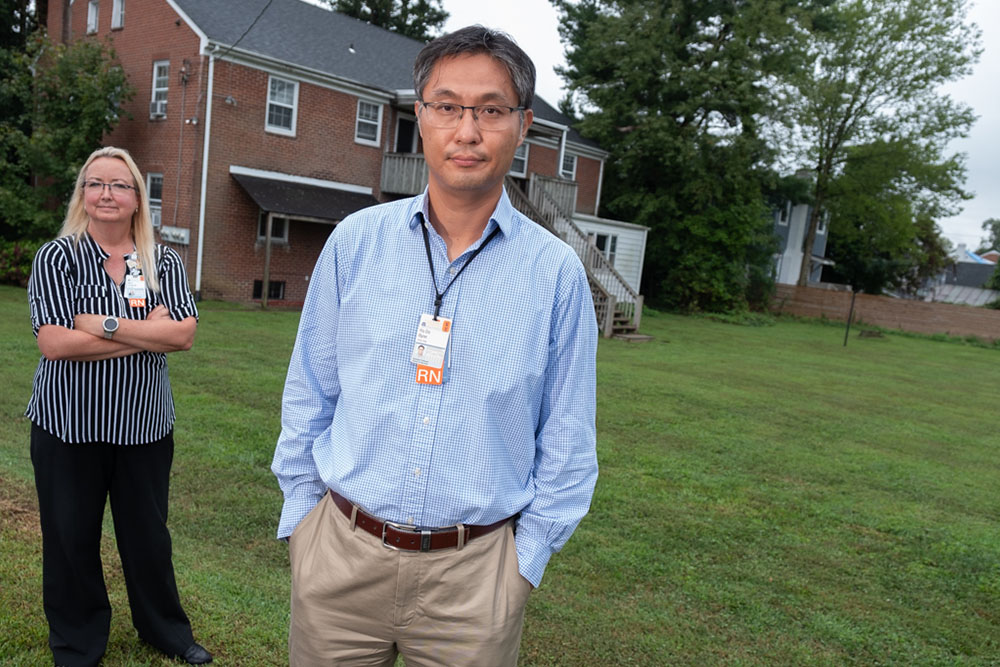Crossing the Threshold

How often do home visiting nurses face violence from their patients?
 As a former visiting nurse at a home healthcare agency, assistant professor Ha Do Byon knows the issues caregivers face when crossing the threshold of a patient’s home. He and his research partner Mary Crandall (PhD ’15), director of UVA’s Continuum Home Health, have stories to tell.
As a former visiting nurse at a home healthcare agency, assistant professor Ha Do Byon knows the issues caregivers face when crossing the threshold of a patient’s home. He and his research partner Mary Crandall (PhD ’15), director of UVA’s Continuum Home Health, have stories to tell.
One patient blared pornography when the nurse arrived. Another groped his nurse as she administered care. Another patient waved a handgun, while family members of another patient lay intoxicated on the floor. Then there is the biting, the punching, kicking, slaps, and hair-pulling. Screaming fits, hurled curses, objects thrown, and dogs that bite, or threaten to.
1/2
Roughly half of home-visiting nurses experience violence from patients
“Hospitals have policies they impose on patients during their stay—you can do this, but can’t do that,” said Byon, “but visiting nurses go into a patient’s home where they’re guests and the rules at play feel different.”
In previous research, Byon found that roughly half of home health nurses experience non-physical violence, and 15 percent are physically threatened each year. Between 20 and 75 percent of patient-on-nurse violence is reported in hospitals, but when it occurs in patients’ homes, explained Byon, nurses are even less likely to report it. In previous studies, Byon and Crandall found that home health nurses often viewed violence as a necessary part of the work environment, felt unsure as to whether an incident “counted” as a violent act, or, were uncertain about reporting mechanisms. In hospitals, roughly a quarter of nurses who formally report violence do so through documentation in their clinical notes—part of the Electronic Health Record (EHRs)—a repository where patient notes are shared between caregivers. The problem with that, explained Byon, is that few nurse managers are able to review these notes due to the volume of visits provided each day.
“Nurses are not reporting that this violence is taking place,” says Byon, “and if it’s not reported, or is noted through informal channels, like nurses’ clinical notes, managers don’t know whether violence is occurring and what risks might be dealt with and mitigated.”
Beginning this winter, Byon will use machine learning and natural language processing to comb through hundreds of thousands of home health nurses’ clinical notes to better understand the frequency of violence and how it’s captured in EHRs. With Crandall and co-investigator Max Topaz, of Columbia University School of Nursing, developer of the language processing software program Nimble Miner, Byon will analyze 750,000 clinical notes from the Visiting Nurses Association of the State of New York, the world’s largest home health nursing agency, and 20,000 from UVA’s Continuum Home Health. With a better sense of the frequency of violence, his ultimate goal is to develop systems to easily capture violent incidents in a timely way, and build more robust policies to prevent such violence so the nation’s more than 266,000 home health nurses are supported and protected while out in the field.
Documenting violence benefits patients, too, who may need mental health and behavioral specialists. Building a true picture of the frequency of violence home health nurses face, Byon and Crandall said, will preserve the health and well-being of this increasingly relied-upon group of home visiting nurses whose distinct set of skills must be better appreciated.
“These nurses have the experience and courage to walk into someone’s home that they’ve never met before, especially at a moment when the patient’s not feeling well and other family members might feel distraught,” said Crandall “They’re skilled at calming the situation and helping people understand and better cope with their diseases, pain management, and other challenges. It only takes that one situation, though, for them to feel that the job is too much of a challenge, and doesn’t feel safe. Leaders don’t want that. We have to find ways to support our nurses so they don’t feel so vulnerable.”
Byon’s work is supported with a grant from the Eugenie and Joseph Doyle Research Partnership Fund. Results of the pilot study are expected by next fall.
###
